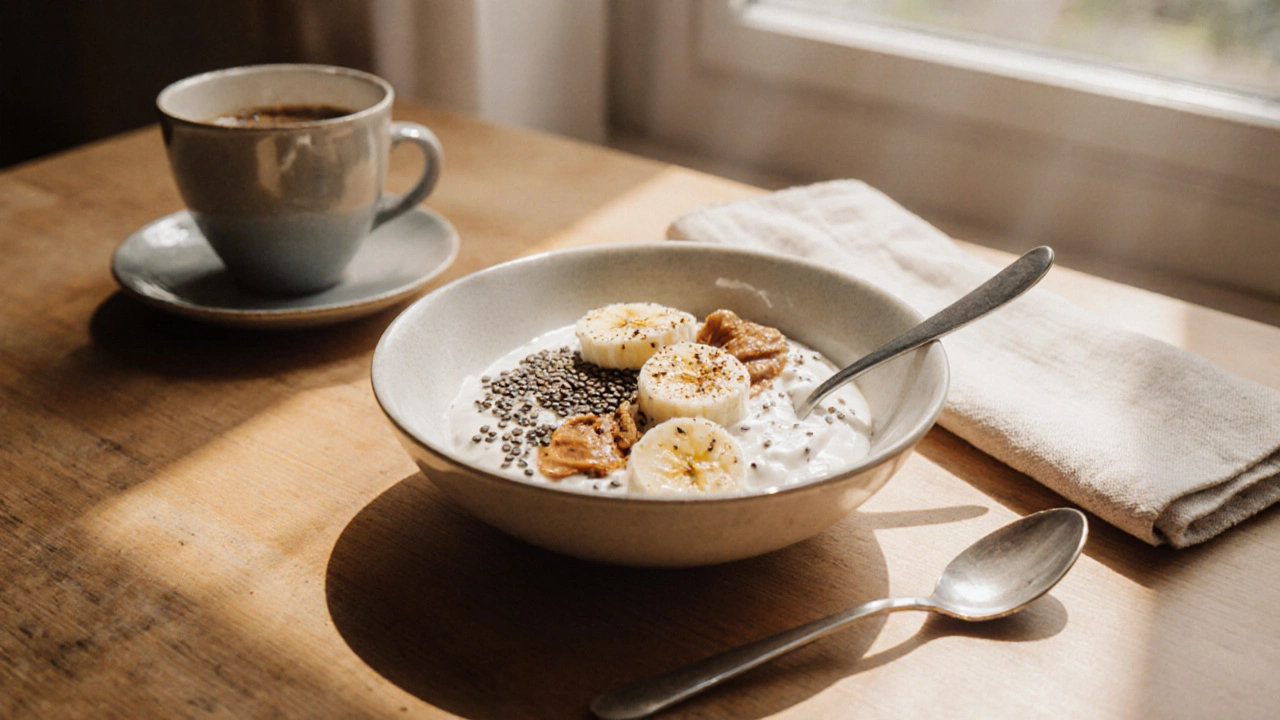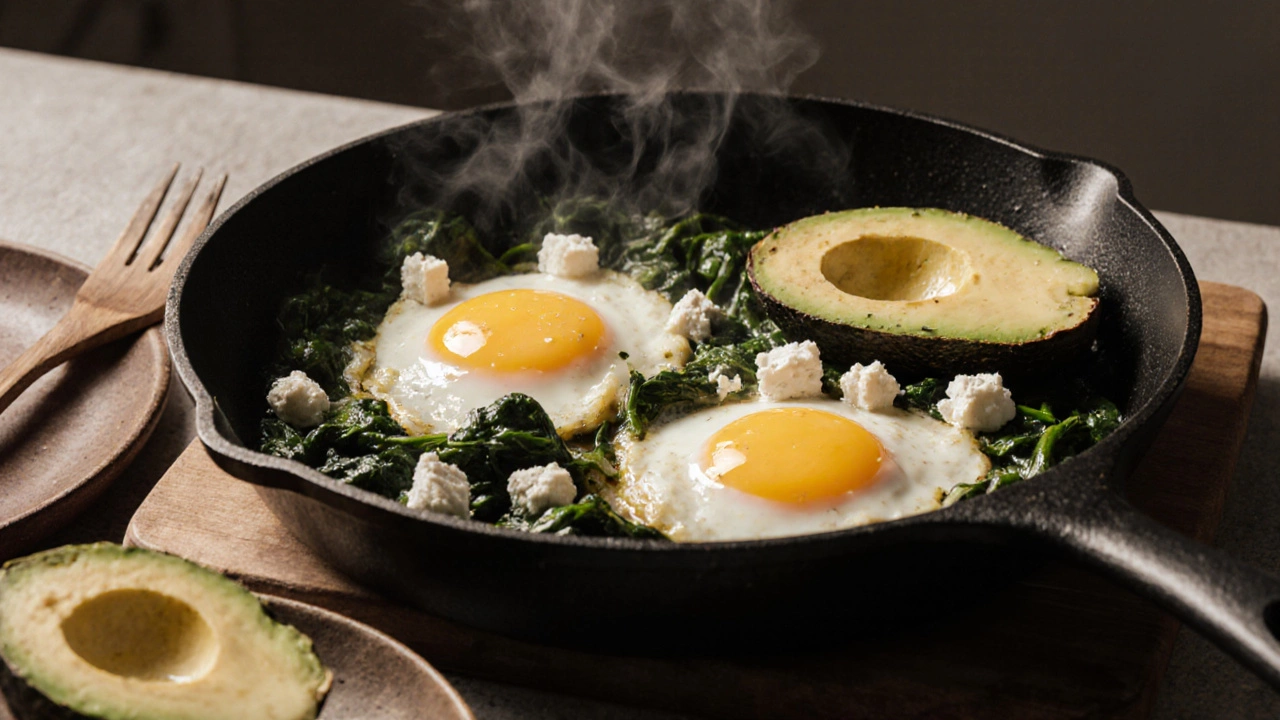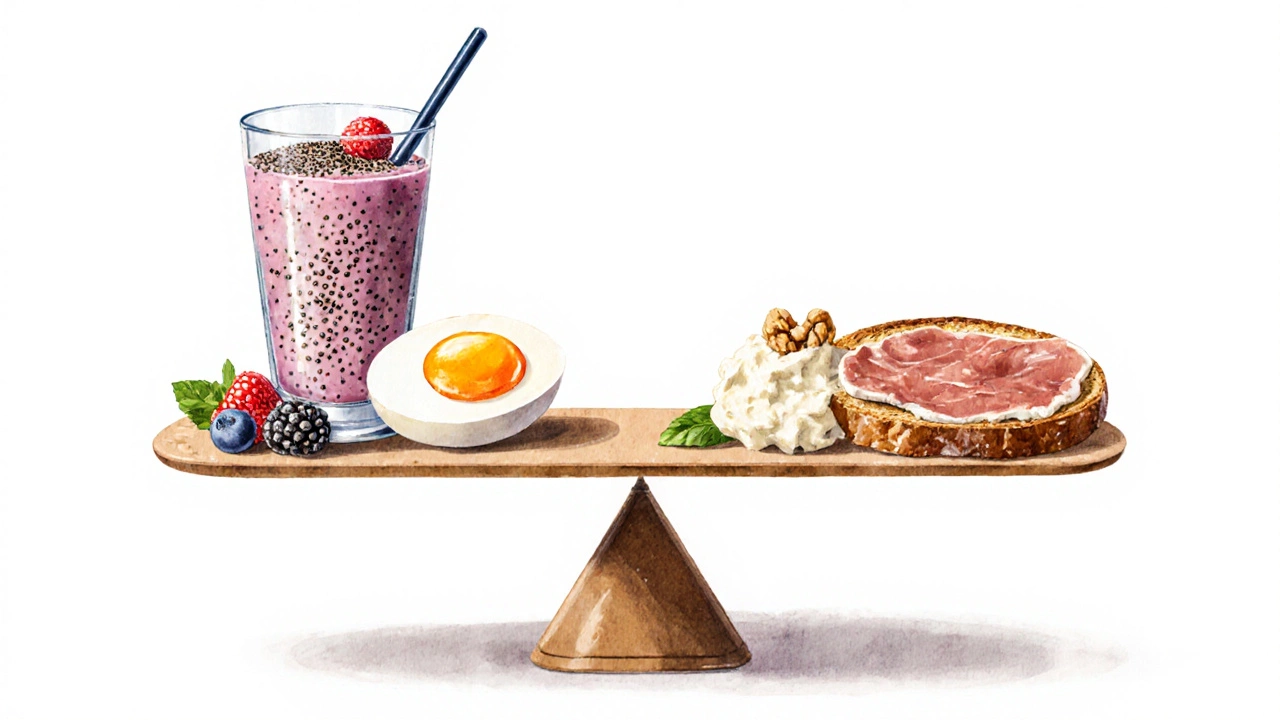
Select foods from the table below and adjust quantities to meet your protein goal (20-30g)
Total Protein: 0g
Aim for 20-30g protein for optimal energy and fullness.
Starting your day with a good protein breakfast isn’t just a trend-it’s a practical move that keeps you full, stabilizes your blood sugar, and gives you steady energy until lunch. If you’ve ever felt hungry by 10 a.m. after eating toast or cereal, you know why this matters. Protein doesn’t just build muscle; it slows digestion, reduces cravings, and helps your body recover from the night’s fast. But what does a real, satisfying protein breakfast actually look like? It’s not just a shake you chug on the way out the door.
Your body breaks down muscle overnight while you sleep. Without protein in the morning, it keeps pulling from your muscles to fuel basic functions. A study from the Journal of Nutrition found that people who ate at least 25 grams of protein at breakfast had significantly lower hunger levels throughout the day compared to those who ate less than 10 grams. That’s not magic-it’s biology.
Protein also helps regulate insulin. When you eat carbs alone-like a bagel or pancakes-your blood sugar spikes and crashes. That’s the crash you feel by mid-morning. Add protein, and that spike flattens out. You stay alert, focused, and less likely to reach for a sugary snack.
And yes, protein shakes can be part of this. But they shouldn’t be the whole story. A shake alone often lacks fiber, healthy fats, and micronutrients. A balanced breakfast does.
You don’t need a kitchen full of gadgets or expensive superfoods. Here are seven simple, real-life options that deliver 20-30 grams of protein each, using ingredients you can find at any supermarket.
Protein shakes are convenient. They’re fast. They’re easy to measure. But they’re not always the best choice for breakfast-unless you pair them right.
A shake with just protein powder and water? You’ll be hungry again in 90 minutes. Why? Because your body needs more than amino acids. It needs fiber, fat, and micronutrients to feel truly satisfied.
Here’s how to make a protein shake that actually works as a breakfast:
This version has 25-35g protein, 8-10g fiber, and healthy fats. That’s a real meal. Not a drink you gulp down while scrolling.
Also, avoid protein shakes with added sugar, artificial sweeteners, or “energy blends.” Look at the label. If it has more than 5g of sugar per serving, skip it. The protein isn’t doing you any good if the rest of the ingredients are junk.

Not all “healthy” breakfasts are high in protein. Many are just sugar with a side of carbs.
These foods might feel like breakfast, but they don’t act like it. They spike your blood sugar, leave you craving more, and make it harder to stick to your goals.
You don’t need 100 grams of protein at breakfast. That’s not realistic or necessary. For most adults, aim for 20-30 grams in the morning. That’s enough to kickstart muscle repair and curb hunger.
Here’s a quick guide:
| Food | Amount | Protein (g) |
|---|---|---|
| Egg | 1 large | 6 |
| Greek yogurt | 170g | 17 |
| Cottage cheese | 1 cup | 14 |
| Whey protein powder | 1 scoop | 20-25 |
| Chicken breast | 100g | 31 |
| Tuna | 1 can (120g) | 25 |
| Almond butter | 1 tbsp | 3 |
| Oats | 1/2 cup dry | 5 |
If you’re active, training, or trying to lose weight, aim for the higher end. If you’re sedentary, 20g is fine. But don’t go below 15g. Anything less won’t trigger muscle protein synthesis effectively.

If you’re short on time, plan ahead. You don’t need to cook every morning.
These small habits add up. You won’t have to choose between eating something fast and eating something good.
You don’t need a perfect protein breakfast every single day. But if you get it right 5 out of 7 mornings, you’ll notice the difference. Less hunger. Fewer cravings. More energy. Better focus.
Start with one change this week. Swap your cereal for Greek yogurt. Or add a hard-boiled egg to your toast. That’s it. Build from there.
Protein isn’t about bodybuilding. It’s about feeling steady. It’s about not needing a snack at 10 a.m. It’s about starting your day with fuel that lasts.
A protein shake alone isn’t enough for a balanced breakfast. While it gives you protein, it often lacks fiber, healthy fats, and micronutrients. To make it a complete meal, add chia seeds, flaxseed, nut butter, or fruit. A shake with these additions can be a great breakfast-but don’t rely on it daily without variety.
Aim for 20-30 grams of protein at breakfast. This amount is enough to trigger muscle repair, reduce hunger, and stabilize blood sugar. For most people, this is achievable with options like Greek yogurt, eggs, cottage cheese, or a well-made protein shake. Going below 15g won’t provide the full benefits.
Absolutely. Plant-based options like tofu scramble, soy yogurt, pea protein shakes, lentils, cottage cheese (if you eat dairy), chia seeds, hemp seeds, and nut butters all deliver solid protein. Combine them with whole grains and veggies for a complete meal. A tofu and spinach breakfast bowl with tempeh bacon can easily hit 25g protein.
Most protein bars are not ideal breakfasts. Many contain added sugars, artificial sweeteners, and fillers. Even bars labeled “healthy” often have less than 10g protein and more sugar than a chocolate bar. If you use one, check the label: aim for at least 15g protein, under 5g sugar, and recognizable ingredients. Better yet, use them as a snack, not a meal replacement.
Whey protein is fast-absorbing and complete, making it great for morning use. Casein digests slowly and can help you stay full longer. Plant-based options like pea, rice, or soy protein work well too-especially if you’re vegan or lactose intolerant. Look for powders with no added sugar, minimal ingredients, and at least 20g protein per scoop. Avoid anything with “digestive enzymes” or “energy blends” unless you know what’s in them.
Yes-protein is one of the best tools for weight loss. It reduces hunger, helps preserve muscle while cutting calories, and increases the number of calories your body burns during digestion. Focus on whole food sources like eggs, Greek yogurt, and lean meats. Avoid sugary protein shakes or bars. Pair protein with fiber-rich veggies and healthy fats for maximum satiety.
If you’re still hungry, you might be missing fat or fiber. Protein alone doesn’t always fill you up. Add avocado, nuts, seeds, or vegetables to your meal. Also, check your portion sizes-20g of protein might not be enough if you’re very active. Try increasing to 25-30g and see if that helps. Drinking water before eating can also reduce false hunger signals.